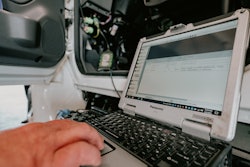This is the final of a four-part series that looks at telemetry data as a maintenance tool in trucking, the information service providers seek to provide fleets, and how fleets use that information. The series is based on a survey conducted this spring by CCJ parent company Randall Reilly. The results can be downloaded here. Additional coverage in this series includes Maintenance telematics: New-age battleground for OEMs and the aftermarket, Technology seeks role as fleet maintenance partner, and OEMs, aftermarket collaborate to fill gaps in telematic data.
The volume of information that flows through and from a Class 8 truck can be overwhelming, leaving important action items unaddressed.
According to a survey conducted earlier this year by CCJ parent company Randall Reilly, 10% of fleet respondents said they have canceled their OEM telematics service because "I got too many emails/alerts."
More than half (57%) of respondents said they either no longer subscribe to or do not plan to renew their OEM telematics subscription. The primary reason cited (52%) was that fleets have other processes in place and the OEM platform is redundant. Next (24%) was the cost of the subscription followed by an inability to integrate the OEM platform with other telematics services (19%).
Another 43% claim to still be within the trial period but plan to renew, but as technologies evolve and new capabilities are added, carriers – especially front-line users – have a list of wants that they believe simplify their way of performing maintenance.
Averitt Express (CCJ Top 250, No. 26) Breakdown Coordinator Tim Gray said he would like the see remote updates bypass the driver, who currently has to authorize it.
"Take it out of the driver's hands like, for example, if Volvo pushed [the update] out, it would happen at the next key cycle," he said.










